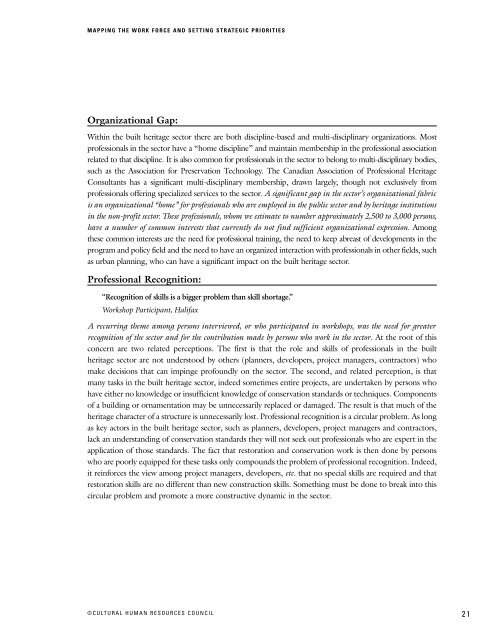Human Resources in Canada's Built Heritage Sector: Mapping the ...
Human Resources in Canada's Built Heritage Sector: Mapping the ...
Human Resources in Canada's Built Heritage Sector: Mapping the ...
- No tags were found...
Create successful ePaper yourself
Turn your PDF publications into a flip-book with our unique Google optimized e-Paper software.
MAPPING THE WORK FORCE AND SETTING STRATEGIC PRIORITIESOrganizational Gap:With<strong>in</strong> <strong>the</strong> built heritage sector <strong>the</strong>re are both discipl<strong>in</strong>e-based and multi-discipl<strong>in</strong>ary organizations. Mostprofessionals <strong>in</strong> <strong>the</strong> sector have a “home discipl<strong>in</strong>e” and ma<strong>in</strong>ta<strong>in</strong> membership <strong>in</strong> <strong>the</strong> professional associationrelated to that discipl<strong>in</strong>e. It is also common for professionals <strong>in</strong> <strong>the</strong> sector to belong to multi-discipl<strong>in</strong>ary bodies,such as <strong>the</strong> Association for Preservation Technology. The Canadian Association of Professional <strong>Heritage</strong>Consultants has a significant multi-discipl<strong>in</strong>ary membership, drawn largely, though not exclusively fromprofessionals offer<strong>in</strong>g specialized services to <strong>the</strong> sector. A significant gap <strong>in</strong> <strong>the</strong> sector’s organizational fabricis an organizational “home” for professionals who are employed <strong>in</strong> <strong>the</strong> public sector and by heritage <strong>in</strong>stitutions<strong>in</strong> <strong>the</strong> non-profit sector. These professionals, whom we estimate to number approximately 2,500 to 3,000 persons,have a number of common <strong>in</strong>terests that currently do not f<strong>in</strong>d sufficient organizational expression. Among<strong>the</strong>se common <strong>in</strong>terests are <strong>the</strong> need for professional tra<strong>in</strong><strong>in</strong>g, <strong>the</strong> need to keep abreast of developments <strong>in</strong> <strong>the</strong>program and policy field and <strong>the</strong> need to have an organized <strong>in</strong>teraction with professionals <strong>in</strong> o<strong>the</strong>r fields, suchas urban plann<strong>in</strong>g, who can have a significant impact on <strong>the</strong> built heritage sector.Professional Recognition:“Recognition of skills is a bigger problem than skill shortage.”Workshop Participant, HalifaxA recurr<strong>in</strong>g <strong>the</strong>me among persons <strong>in</strong>terviewed, or who participated <strong>in</strong> workshops, was <strong>the</strong> need for greaterrecognition of <strong>the</strong> sector and for <strong>the</strong> contribution made by persons who work <strong>in</strong> <strong>the</strong> sector. At <strong>the</strong> root of thisconcern are two related perceptions. The first is that <strong>the</strong> role and skills of professionals <strong>in</strong> <strong>the</strong> buil<strong>the</strong>ritage sector are not understood by o<strong>the</strong>rs (planners, developers, project managers, contractors) whomake decisions that can imp<strong>in</strong>ge profoundly on <strong>the</strong> sector. The second, and related perception, is thatmany tasks <strong>in</strong> <strong>the</strong> built heritage sector, <strong>in</strong>deed sometimes entire projects, are undertaken by persons whohave ei<strong>the</strong>r no knowledge or <strong>in</strong>sufficient knowledge of conservation standards or techniques. Componentsof a build<strong>in</strong>g or ornamentation may be unnecessarily replaced or damaged. The result is that much of <strong>the</strong>heritage character of a structure is unnecessarily lost. Professional recognition is a circular problem. As longas key actors <strong>in</strong> <strong>the</strong> built heritage sector, such as planners, developers, project managers and contractors,lack an understand<strong>in</strong>g of conservation standards <strong>the</strong>y will not seek out professionals who are expert <strong>in</strong> <strong>the</strong>application of those standards. The fact that restoration and conservation work is <strong>the</strong>n done by personswho are poorly equipped for <strong>the</strong>se tasks only compounds <strong>the</strong> problem of professional recognition. Indeed,it re<strong>in</strong>forces <strong>the</strong> view among project managers, developers, etc. that no special skills are required and thatrestoration skills are no different than new construction skills. Someth<strong>in</strong>g must be done to break <strong>in</strong>to thiscircular problem and promote a more constructive dynamic <strong>in</strong> <strong>the</strong> sector.©CULTURAL HUMAN RESOURCES COUNCIL21










